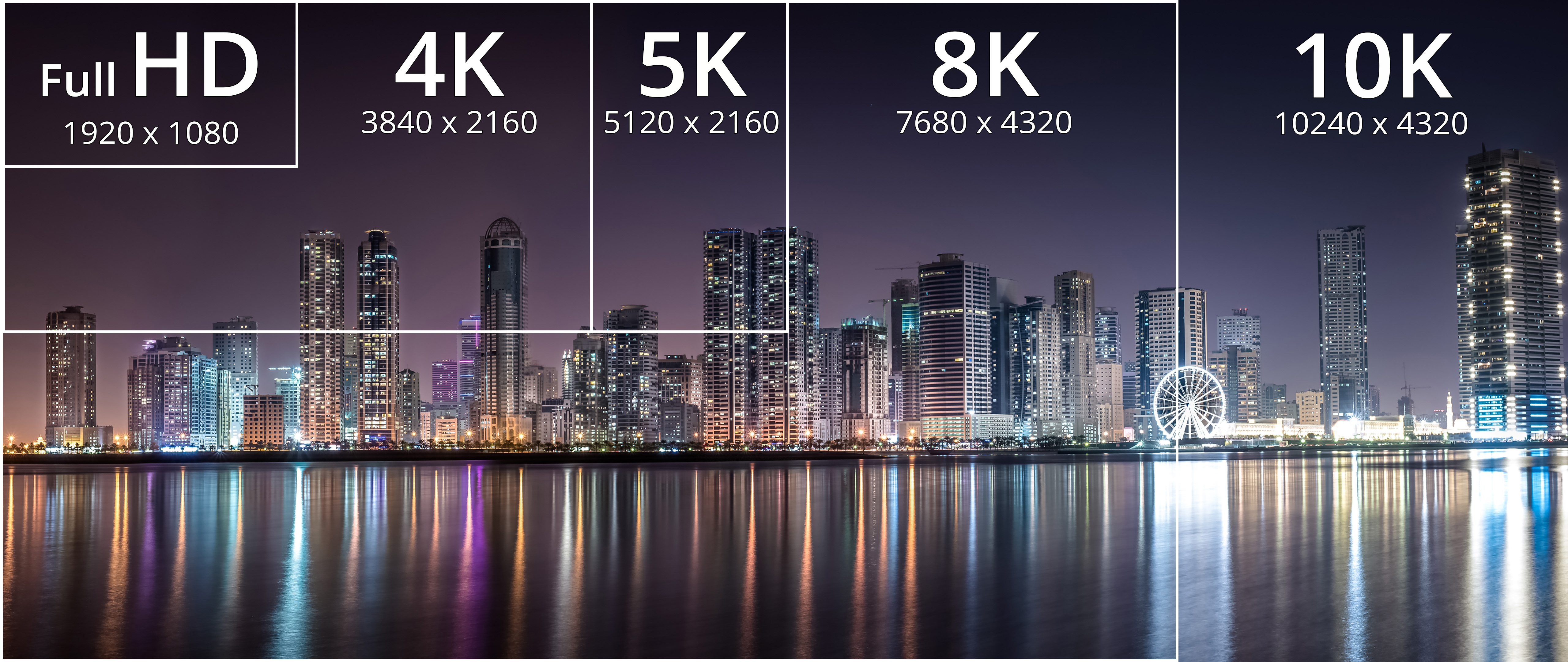Progress toward 4K becoming the predominant display resolution has been slow and steady. More than 15 years after the technology’s debut, almost every television upwards of 50 inches is capable of 4K display. (4K UHD—the UHD stands for ultra-high definition—is the term for 4K resolution on a 16:9 screen. It represents 3,840 pixels wide by 2,160 pixels tall—almost 4,000 pixels across, from which the standard derives its name. 4K UHD is four times the resolution of 1920 x 1080 HD video.) At the same time, high-resolution content and accessories have evolved to firmly imprint 4K as a selling point to consumers—assisted in large part by streaming services shooting and delivering 4K video content in increasing volume over the past five years.
But just as 4K stands newly crowned, 8K, and to a lesser degree 10K, are making inroads into public consciousness. (In television terms, 8K UHD represents a resolution of 7,680 by 4,320 pixels. The next step up, 10K, has not yet been standardized.) At the CES convention earlier this year, Samsung revealed its Q900 8K television, while LG showed off its $30,000 88-inch 8K Z9 OLED, and Sony debuted its Master Series Z9G 8K HDR TV. While still extraordinarily expensive, and by extension nearly unattainable by the masses, 8K is predicted to have a faster adoption rate than its predecessor once prices start coming down.

“From Vanco’s perspective, we agree that 4K is still very much the standard for system design and installation, especially in the residential market,” said Brandon White, director of new product development, Vanco International. “However, we see 8K and 10K becoming more relevant more quickly in the commercial market. This is especially true in larger installations such as stadiums, where screens and video walls are often enormous, making 8K and 10K resolutions not only desired but to some degree required in order to guarantee a sharp picture. In general, the larger the screen size, the more important higher resolutions are becoming.”
Research by Futuresource Consulting bears this out, with 8K TV shipments expected to grow from 200,000 in 2019 to nearly six million units in 2023 as brands push the technology to support higher average selling prices. These numbers are further supported by data that shows, according Futuresource market analyst Chris Evans, that while Samsung and Sharp are currently the heavy hitters in the 8K TV technology arena, most other brands will likely launch 8K sets in the near future, with Chinese manufacturers leading the charge.
“8K broadcasting and content creation will remain niche to begin with,” Evans said. “The higher resolution will be more data-intensive and will increase the cost of production throughout the workflow from the point of capture on set. Despite the higher cost of production, achieving return on investment for increases in resolution is uncertain as monetizing resolution increases can be difficult, as has been proven with the [ongoing] transition to 4K.”
While most people are now fully onboard with 4K and the growing spectrum of content to make it worthwhile, there is still room for 4K to improve, and with that comes a slower move toward the adoption of higher resolutions on the consumer level. As manufacturers and tech providers continue to build the infrastructure to support the delivery of 4K content, they are laying the groundwork for what we can expect to see in future rollouts for 8K and eventually 10K systems.
[How 4K Displays Can Be The Answer to a Variety of Visual Needs]

“Christie has supported native 4K since 2011,” said Larry Paul, executive director, technology and custom solutions, Christie. “The 4K standard took longer to adopt than HD previously. The reasons for adoption speed vary, including content availability, signal distribution, and viewer expectations. Right now, there is no pressing need in any of these three categories for 8K resolution; however, there is some expectation from the market that technology needs to progress, and 8K appears to be the next step. Historically, higher resolutions have taken longer to gain a foothold. For example, HD took two years; 4K took five years.”
“As manufacturers, we must prepare for higher resolutions, but we must also continue to support and expand on the existing 4K market need,” he added. “At Christie, we do this by pushing the capabilities of the standard in higher refresh rates (120 Hz, 240 Hz, 480 Hz, etc.) and fully supporting the color space requirement.”
Market Perception
One of the major challenges for the layperson to overcome with increasing resolution is the often imperceptible difference between 4K, 8K, and 10K except on enormous screens. The consumer selling point for 4K has always been cleaner, sharper images—a critical consideration as screens grow larger by the year—but for professional AV, the push toward 8K has its benefits, especially in the evolution of technology accessories and the delivery of content in relation to expanding screen sizes.
[Is It Too Soon to Be Talking About 8K?]
“There are not a lot of tools available today that can handle 8K,” said Vanco’s White. “However, as 4K becomes the new norm and 8K breaks through, the latest HDMI specification is becoming increasingly desirable to integrators in both the residential and commercial markets. From the perspective of HDMI, the release of the Compliance Test Specification (CTS) will help clarify and create a foundation for manufacturers to move forward with 8K-supportive products. This technology development will help to better establish 8K and 10K resolutions, and as a result will lead to an expansion in cable and fiber product offerings.”
As Evans pointed out, image sensors capable of 8K acquisition have already been developed and are present in high-end digital cinema cameras and system cameras manufactured by Sony, RED Digital Cinema, Panasonic, Ikegami, and Sharp. “A majority of 8K productions so far have been based around Quad Link 12G-SDI,” Evans added. “The ecosystem of 12G-SDI products has grown notable, with a number of key manufacturers incorporating the connectivity into production equipment announced in 2019.”
Content Creation
What does this all mean for 8K content delivery? Currently, there is just a minuscule amount of 8K video content available, even while camera technology exists to capture still 8K images. This is due to a list of notable hinderances as outlined by Evans, including insufficient bandwidth to deliver 8K video, the inability of some boxes to display 8K content, and a lack of a large enough 8K installation base to make it worth the investment now.

“Beyond waiting for a large enough consumer audience that can actually view 8K content, a significant requirement for the growth of 8K content will be the adoption of new codecs, which are in development, that can efficiently compress the video to make delivery technologically feasible,” said Evans.
Recent demonstrations of 8K content delivery under current infrastructure conditions have shown the viability of the resolution in the coming years. As examples, Evans highlighted NHK’s launch of the first 8K television channel, BS8K, last December, and BT Sports’ showcase of its 8K workflow with a live demonstration of the Gallagher Premiership Rugby 7s tournament during IBC 2019 in September.
[Coming Together: How Integrators and Content Creators Can Make It Work]
“The broadcast was natively IP, using an Appear TV X10 control/switch module for encoding, decoding, and interfacing with the BT network,” Evans said of the rugby broadcast. “BT made use of the Ikegami SHK-810 camera for image acquisition. While this wasn’t the first time 8K has been demonstrated live, this was significant in showcasing the capabilities of IP technology in superseding coax-based SDI infrastructure due to its higher bandwidth capacity and greater connectivity between devices.”
These demonstrations highlight which parts of the market will be pushing for 8K and 10K video delivery, namely the live broadcasting and performances sectors. Evans anticipates the 8K revolution to start as early as a few months from now, just in time for the Olympics and to ride the groundswell of popularity esports is gaining.
“For commercial installations, the resolution application is available on an as-needed basis,” Evans noted. “However, there is a major emphasis on 8K and 10K resolution for the 2020 Summer Olympics in Tokyo, Japan. We are also hearing about plans for higher resolutions in the gaming industry with consoles like the Xbox Project Scarlett. Based on this, we expect to see a mainstream movement for 8K and beyond in as early as nine to 12 months. The technology evolution required to establish the 8K/10K standards will be the ability to maintain consistent bandwidth and refresh rates, which we expect enhancements in fiber and HDMI will help with.”
Integration Now
On the content production side of the business, 8K and 10K are viable choices for content creators right now, as it is generally accepted that content captured in a resolution higher than it will be distributed in offers greater flexibility in post-production. But consumers and integrators can also take advantage of these higher resolutions now.

“There are three factors that will drive customers to adopt 8K resolution: content, lower-cost signal distribution, and viewer expectations,” said Mike Garrido, senior product manager, Christie.
Integrators are helping by choosing which resolution is right for each application. As White outlined, 8K and 10K are being used for large screens and video wall installations that demand higher resolutions and faster frame refresh rates (stadiums, museums, etc.), while the current 4K standard works best for smaller spaces such as restaurants, bars, and hotel lobbies.
“Time and stability are required in order for customers to buy in to higher resolutions,” White added. “Typically, 8K/10K applications are used in highly visible large-screen installations, so to get buy in, the customer needs to know that not only is there 8K/10K content available, but that the content will be presented with a consistent and reliable signal.”
[A Look at M4300's Ability to Move 4K Video]
Beyond the integration and viewing benefits, higher resolutions are anticipated to offer integrators opportunities to become creative content producers themselves, especially when paired with other emerging AV technologies.
“Higher resolutions will always benefit VFX work, as more visual data will enable more accurate object tracking in the scene to use when compositing visual effects,” Evans concluded. “AV integrators will have an opportunity to create more immersive experiences with large outdoor screens in venues and stadiums for concerts and sports. Immersive 360-degree video and VR experiences will also improve as higher resolutions become available, as more image resolution increases the level of detail across the 360-degree horizon in an experience.”
